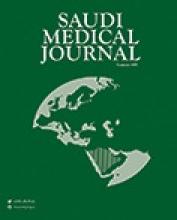Abstract
OBJECTIVE: To assess the circulating rotavirus strains among hospitalized children and adults in Gizan City.
METHODS: This cross-sectional study was based in 5 hospitals in the Gizan area. Stool samples were collected between November 2004 and March 2005, from sequential patients with acute, dehydrating diarrhea. Rotavirus antigen was detected in stool by enzyme-linked immunosorbent assay. The diversity of rotavirus strains was investigated using electropherotying and reverse transcription-polymerase chain reaction amplification of the VP7 and VP4 genes (G and P genotyping).
RESULTS: Rotavirus was detected in 54 of 454 (12%) subjects. The ages of those infected with rotavirus ranged from 15 days to 20 years, with a median age of 36 months. The highest rotavirus detection rate (24%) occurred in children aged 48-59 months. Overall, 50 (93%) of strains could be assigned both a G- and P-type; G1P[8] was the most frequently detected strain type (n=48, 89%) with one rotavirus each of G2P[4] and G9P[8].
CONCLUSION: Rotavirus strains circulating in Gizan would be well covered by current rotavirus vaccines. Rotavirus serotype G9 has been detected in Saudi Arabia for the first time. Continued surveillance of rotavirus strains is required.
- Copyright: © Saudi Medical Journal
This is an open-access article distributed under the terms of the Creative Commons Attribution-Noncommercial-Share Alike 3.0 Unported, which permits unrestricted use, distribution, and reproduction in any medium, provided the original work is properly cited.






